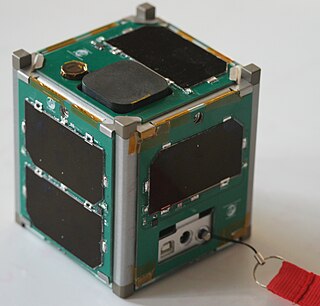AMSAT is a name for various amateur radio satellite organizations worldwide. In particular, it often refers to the Radio Amateur Satellite Corporation, headquartered in Washington, D.C. AMSAT organizations design, build, arrange launches for, and then operate (command) satellites carrying amateur radio payloads, including the OSCAR series of satellites. Other informally affiliated national organizations exist, such as AMSAT Germany (AMSAT-DL) and AMSAT Japan (JAMSAT).

A CubeSat is a class of small satellite with a form factor of 10 cm (3.9 in) cubes. CubeSats have a mass of no more than 2 kg (4.4 lb) per unit, and often use commercial off-the-shelf (COTS) components for their electronics and structure. CubeSats are deployed into orbit from the International Space Station, or launched as secondary payloads on a launch vehicle. As of December 2023, more than 2,300 CubeSats have been launched.

A small satellite, miniaturized satellite, or smallsat is a satellite of low mass and size, usually under 1,200 kg (2,600 lb). While all such satellites can be referred to as "small", different classifications are used to categorize them based on mass. Satellites can be built small to reduce the large economic cost of launch vehicles and the costs associated with construction. Miniature satellites, especially in large numbers, may be more useful than fewer, larger ones for some purposes – for example, gathering of scientific data and radio relay. Technical challenges in the construction of small satellites may include the lack of sufficient power storage or of room for a propulsion system.
The Canadian Advanced Nanospace eXperiment (CanX) program is a Canadian CubeSat nanosatellite program operated by the University of Toronto Institute for Aerospace Studies, Space Flight Laboratory (UTIAS/SFL). The program's objectives are to involve graduate students in the process of spaceflight development, and to provide low-cost access to space for scientific research and the testing of nanoscale devices. The CanX projects include CanX-1, CanX-2, the BRIght Target Explorer (BRITE), and CanX-4&5.
CAPE-1(Cajun Advanced Picosatellite Experiment) is an amateur miniaturized satellite developed by students at the University of Louisiana at Lafayette. The CubeSat was launched successfully into orbit at the Baikonur Cosmodrome in Kazakhstan in April 2007 after a delay of several weeks.
MaSat-1 is the first indigenous Hungarian satellite, developed and built by students at the Technical University of Budapest. The 1U CubeSat-type satellite was launched into low Earth orbit on 13 February 2012. The satellite provided telemetric data as well as VGA resolution color images at the 70 cm amateur radio wavelength received at the tracking center at Budapest. The center was tested on 31 March 2009 with the help of Charles Simonyi on board the International Space Station. With the successful launch of MaSat-1, Hungary became the 47th nation to orbit a satellite. Between 9 and 10 January 2015, the satellite reentered into the atmosphere.
ITUpSAT1, short for Istanbul Technical University picoSatellite-1, is a single CubeSat built by the Faculty of Aeronautics and Astronautics at the Istanbul Technical University. It was launched on 23 September 2009 atop a PSLV-C14 satellite launch vehicle from Satish Dhawan Space Centre, Sriharikota, Andhra Pradesh in India, and became the first Turkish university satellite to orbit the Earth. It was expected to have a minimum of six-month life term, but it is still functioning for over two years. It is a picosatellite with side lengths of 10 centimetres (3.9 in) and a mass of 0.990 kilograms (2.18 lb).

The NASA Launch Services Program (LSP) is responsible for procurement of launch services for NASA uncrewed missions and oversight of launch integration and launch preparation activity, providing added quality and mission assurance to meet program objectives. LSP operates under the NASA Space Operations Mission Directorate (SOMD).
Technology Education Satellite (TechEdSat) is a successful nano-sat flight series conducted from the NASA Ames Research Center in collaboration with numerous universities. While one of the principal aims has been to introduce young professionals and university students to the practical realm of developing space flight hardware, considerable innovations have been introduced. In addition, this evolving flight platform has tested concepts for Low Earth Orbit (LEO) sample return, as well as planetary nano-sat class mission concepts.
PW-Sat is a series of Polish CubeSats designed and built by students at the Warsaw University of Technology in conjunction with the Faculty of Power and Aeronautical Engineering of Warsaw University of Technology, the Space Research Centre of Polish Academy of Sciences, and the European Space Agency. As of January 1, 2024, there have been 2 PW-Sats with a third in development. The first PW-Sat was the first Polish artificial satellite which was launched 13 February 2012 from ELA-1 at Guiana Space Centre aboard Italian-built Vega launch vehicle during its maiden voyage. After their graduation, the team that developed the original PW-Sat have also worked to develop the subsequent missions, establishing a private company named PW-Sat to design and manufacturer the PW-Sats, all of which test novel deorbiting methods, with the overall goal of the program to develop solutions to space debris.
STRaND-1 is a failed 3U CubeSat developed by Surrey University's Surrey Space Centre (SSC) and Surrey Satellite Technology (SSTL). The 4.3 kg (9.5 lb) nanosatellite was launched into orbit on board a PSLV Rocket from India on February 25, 2013, Smartphones have flown in space before inside the International Space Station, and the computer from a PDA launched inside two Japanese CubeSats in 2006 and 2008.

ESTCube-1 is the first Estonian satellite and first satellite in the world to attempt to use an electric solar wind sail (E-sail). It was launched on 7 May 2013 aboard Vega VV02 carrier rocket and successfully deployed into orbit. The CubeSat standard for nanosatellites was followed during the engineering of ESTCube-1, resulting in a 10×10×11.35 cm cube, with a volume of 1 liter and a mass of 1.048 kg.

The Vermont Lunar CubeSat is a CubeSat satellite by Vermont Technical College and funded in part by grants from NASA and the Vermont Space Grant Consortium and in part by voluntary donations. The satellite, costing about US$50,000 to build — with NASA offering a free launch as part of the ELaNa program — served as a testing model for guidance and navigation pending future launches. The eventual goal of the project is to build a CubeSat capable of orbiting the Moon.

SkyCube was an American crowdsourced CubeSat. It was first announced on Kickstarter on 14 July 2012 and successfully funded on 12 September 2012, meeting its US$82,500 goal with a total of US$116,890. It was developed and built in 2012–2013, completed flight integration at Nanoracks in late 2013, and launched aboard the Cygnus CRS Orb-1 flight at the Mid-Atlantic Regional Spaceport on Wallops Island, Virginia on 9 January 2014. SkyCube was deployed from the International Space Station on 28 February 2014. Contact with the satellite was last made on 27 March 2014. SkyCube re-entered the Earth's atmosphere on 9 November 2014. It is one of several crowdfunded satellites launched during the 2010s.

The Nanoracks CubeSat Deployer (NRCSD) is a device to deploy CubeSats into orbit from the International Space Station (ISS).

Mars Cube One was a Mars flyby mission launched on 5 May 2018 alongside NASA's InSight Mars lander. It consisted of two nanospacecraft, MarCO-A and MarCO-B, that provided real-time communications to Earth for InSight during its entry, descent, and landing (EDL) on 26 November 2018 - when InSight was out of line of sight from the Earth. Both spacecraft were 6U CubeSats designed to test miniaturized communications and navigation technologies. These were the first CubeSats to operate beyond Earth orbit, and aside from telecommunications they also tested CubeSats' endurance in deep space. On 5 February 2019, NASA reported that both the CubeSats had gone silent by 5 January 2019, and are unlikely to be heard from again. In August 2019, the CubeSats were honored for their role in the successful landing of the InSight lander on Mars.

ArgoMoon is a CubeSat that was launched into a heliocentric orbit on Artemis 1, the maiden flight of the Space Launch System, on 16 November 2022 at 06:47:44 UTC. The objective of the ArgoMoon spacecraft is to take detailed images of the Interim Cryogenic Propulsion Stage following Orion separation, an operation that will demonstrate the ability of a cubesat to conduct precise proximity maneuvers in deep space. ASI has not confirmed nor denied whether this took place, but several images of the Earth and the Moon were taken.

PicoDragon is a small satellite that followed the 1U type of CubeSat program built by the Vietnam National Satellite Center (VNSC) which belongs to VAST and operated in space for 3 months.

HuskySat-1 is an artificial satellite designed at the University of Washington. It was launched by Cygnus NG-12 from Mid-Atlantic Regional Spaceport Launch Pad 0 on Wallops Island, Virginia to low earth orbit on November 2, 2019. It is a CubeSat, and will demonstrate onboard plasma propulsion and high gain telemetry for low Earth orbit that would be a precursor for an attempt at a larger CubeSat designed for orbital insertion at the Moon.











